Comparative review of 4 options for laying carpet: which one is right for you?
Carpet - flooring, with many advantages. It is warm, aesthetic, wear-resistant and, importantly, affordable. With its help, it is easy to implement any design ideas: a correctly selected carpet will surely fit harmoniously into the interior. The coating is ideal for bedrooms and nurseries - rooms in which a sense of coziness and comfort is especially important. You can walk barefoot on the carpet, it provides good thermal insulation and gives a pleasant tactile sensation. This coating is also distinguished by the speed of the flooring - subject to all the nuances, laying the carpet with your own hands will be easy and trouble-free.
Content
Rules for calculating carpet
If you do not want to encounter a shortage or an overabundance of material in the process of laying the flooring, even before going to the store, make its exact calculation. It is optimal that the whole room is covered with one whole piece of material. Why? Firstly, it is more aesthetically pleasing. Secondly, this way the coating will last much longer.
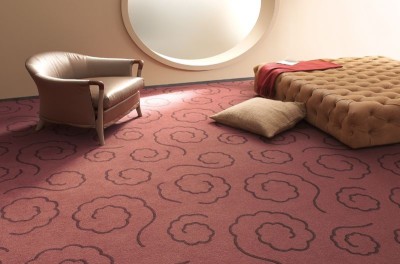
Topic article: How to calculate carpet - examples of calculating carpet with and without a pattern
Draw a plan of the room, which will reflect all the doorways, partitions, niches, etc. and measure all the necessary distances. The carpet should be bought with a small margin - 5-10 centimeters for each side.
How to prepare the foundation before starting work?
Before proceeding with the flooring, the foundation should be carefully prepared.
If the "base" for the material is concrete, you need to repair all the bumps, thoroughly clean and prime the surface. Laying a carpet on a concrete floor without priming it is fraught with a constant "flow" of dust from under the cover - you have to stand guard around the clock with a vacuum cleaner.
As for wooden floors, they can be "processed" in two ways:
- to cover the surface with sheets of chipboard, putty the joints, all to be treated with a primer.
- remove protruding parts (nail caps, screws), loop the surface, prime and pour with a self-leveling mixture.
Topic article: How to level the floor with plywood: analysis of the device 3 different options
So that the carpet does not deteriorate and does not wear out, it is advisable to lay a quality substrate under it. It is proved that it is able to extend the life of the carpet at least one and a half times. Substrate gives the surface elasticity and strength, with it the floor will be even warmer, and sound insulation is even better. Such a “bonus layer” will help create the effect of a dense and thick carpet, even if the coating itself is thin. The substrate, like the carpet, should be purchased with a margin.
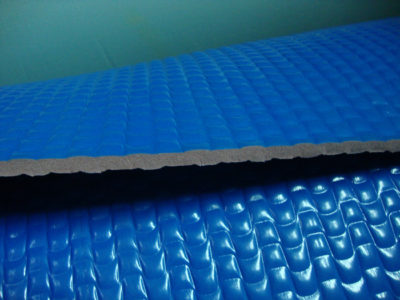
Topic article: Carpet underlay - a whim or a necessity?
Ways of laying carpet
Carpet flooring can be carried out in the following ways:
- loose laying with fixing around the perimeter
- styling using double-sided tape;
- adhesive fixation;
- double gluing (if a substrate is used);
- laying with flu-rails (stretching).
The specific technology for laying carpet is selected depending on:
- the type of material and the nature of its basis;
- the intended purpose of the premises, the level of its patency;
- condition of the rough floor.
Option # 1 - Free Stacking
This is the easiest and fastest way to install the coating. Suitable for small rooms where you can guaranteed to get by with a single piece of carpet.
Work order:
- Lay the mortar, fasten it with a stapler every 20 centimeters, glue the joints with tape.
- Roll the canvas with an allowance for the walls (about 5 centimeters).
- Using a conventional roller, align the coating from the center to the walls.
- At the corners, make V-shaped cuts.
- Trim all excess fabric and, pulling it well, secure it with the baseboard.
- Near the doors, fix the coating with a metal rail.
This method does not require thorough surface preparation, no additional waste. But here it is noted relatively low strength of the "design".
Here is a video example of the work:
Option # 2 - fixing on double-sided tape
This method is suitable for both small and large rooms.
Work order:
- Glue double-sided tape first around the perimeter of the floor, and then in the form of a grill with a side of 50 centimeters. The paper film at this stage, of course, is not removed.
- Lay the carpet on the floor and, gradually removing the film, meter by meter, glue the carpet. Stripes of carpeting butt.
- Cut off excess material with a knife.
- Set plinus.
This option is easy to install, the ability to quickly change the coating. But there is a risk of unevenness due to deformation of the adhesive tape.
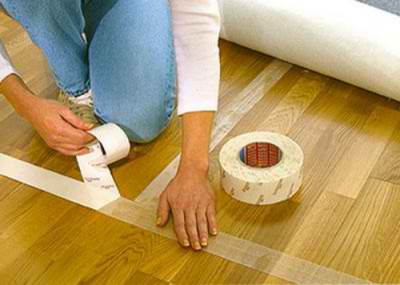
Also, I want to note that in addition to adhesive tape, there are special tapes for fixing:
Option # 3 - adhesive fixation of carpet
It is used in spacious rooms, as well as in rooms with high traffic. This method is quite laborious, but the reward for the work is decent - the absolute reliability of the installation.
Work order:
- Spread the carpet.
- Fold the canvas in half and apply glue to the half of the floor that has opened.
- Return the bent section to the “initial position”, while carefully pressing and stretching the coating.
- Do the same with the second half of the canvas, as well as with the rest of the paintings.
- Cut the carpet and install the skirting board.
This option guarantees durability, durability of laying and a possibility of use for cleaning the washing vacuum cleaner. But then reuse of the coating is excluded.
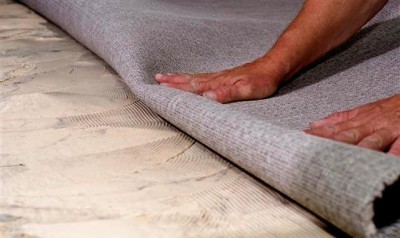
This method is most often used in industrial premises, hotels or trading floors. Where the load on the coating is large enough, there is a need for rigid fixation. In addition, it is better than others for large rooms, where you have to join several canvases of material.
Video example of the work:
Option # 4 - “stretching” or choosing practical ones
This is a glueless laying method carried out using special gripper rails. It is based on the elasticity of carpet, its compliance with tension.
Work order:
- Fasten the flu around the room.
- Lay the substrate, fix it with a stapler.
- Spread the carpet.
- Using a stretcher, pull the coating over the rails in all directions.
- Trim or bend excess material.
- Install the baseboard.
The advantages are that by changing the coating, you can leave the same substrate. But given the method is relevant for rooms whose length and width do not exceed 5 meters, and without sufficient experience it is difficult to produce such a laying.
Laying carpet on the stairs
There are two ways to lay carpet on flights of stairs. The first - "waterfall" - involves the use of a single piece of material. Such laying is possible only on straight stairs.
The second method is called the “cap” and can be used on both straight and spiral staircases. Its essence is that each step is covered with a separate piece of material. As a rule, paper patterns are used to cut carpet. You can get such a pattern by covering the step and the step with a sheet of paper and press it in the corners with a spatula.
Given the increased load on the surface, experts recommend using an adhesive method of laying for flights of stairs. This is how it looks:
Secrets of perfect installation
So that the appearance of the carpet does not deteriorate during installation and subsequent operation, be sure to consider the following nuances:
- Before laying, the coating must be kept at room temperature;
- with direct adhesive fixation, you need to closely monitor whether bubbles and "humps" appear. Pay maximum attention to the high-quality rolling of the coating, since after drying the surface, defects can be eliminated only with the help of radical measures;
- when working with a jute-based carpet, the adhesive composition should be applied very carefully, avoiding its “overdose” - passing through a natural base, excess glue can irreparably disfigure the pile;
- the pattern, continuing through the seam, must be perfectly adjusted in length, width and diagonal - otherwise a high aesthetics of the coating cannot be achieved;
- ensure the same direction of the carpet pile, even if there is no pattern or pattern on the coating;
- carpet trim is best to start from the center, and not from the corner, to prevent unevenness;
- the joint of the paintings will be less noticeable if it is perpendicular to the window (located in the direction of sunlight);
- when cutting off excess coating, always leave a small gap between the material and the wall;
- about a day after laying the carpet is better not to "disturb" - do not walk on it, do not install furniture;
- it is recommended to hide the interior joints of the carpet under special thresholds - in stores you can find appliances for every taste and color.
We hope that our recommendations will help you lay the carpet competently, quickly and efficiently.


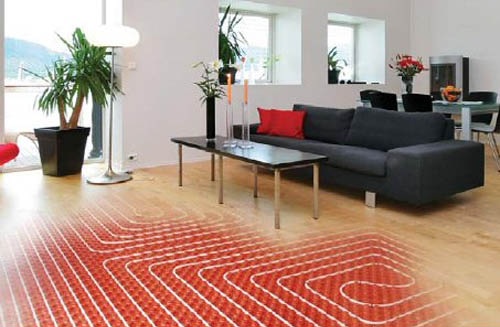

6 comments